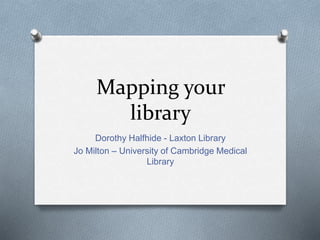
Mapping your library
- 1. Mapping your library Dorothy Halfhide - Laxton Library Jo Milton – University of Cambridge Medical Library
- 2. Library Cognitive Maps: A tool to understand your services and processes, to identify what’s broken and to re-design for a better library experience.
- 3. Traditionally a map is a tool which helps us understand our worlds and envtionemtn It documents where we have been and where we want to get to. It is a tool of explorariona and understanding
- 4. Activity – Part 1 O You have 2 minutes to draw your library/learning space. Please use the black pen. O You have another 2 minutes to add to your drawing. Using the green pen include extra detail/areas which are important to you. O You have another 2 minutes. Using the red pen please add any further detail. If you can include an idea of the routes you would generally take to get from one area to another. O Think about the activities that you do as part of your job
- 5. Activity – Part 2 O Please label the features on your map O You have 5 minutes to discuss your map with your group/partner O Share with the group
- 6. Reflections… O What did you think about the activity? O What did you draw and did it surprise you? O Did you learn anything new about yourself? O Can you use this in your organisation?
- 7. Why use this method O This method assumes that the things people most associate with their “mental map” of the library will appear as elements in the drawing, and that the most important things (or strongest associations) will appear earlier. O Blank spaces of the drawings can also be especially informative. O We recommend utilizing this approach in conjunction with additional interviewing methods that can corroborate and add context to the findings.
- 8. What Next… O Use the maps alongside user led tours of the library. Ask them to highlight likes and dislikes